-
Paper Information
- Paper Submission
-
Journal Information
- About This Journal
- Editorial Board
- Current Issue
- Archive
- Author Guidelines
- Contact Us
Journal of Wireless Networking and Communications
p-ISSN: 2167-7328 e-ISSN: 2167-7336
2016; 6(4): 85-93
doi:10.5923/j.jwnc.20160604.01

A Performance Analysis of E-Learning over WiFi-based Long Distance Networks
Md. I. Hussain, N. Ahmed
Department of Information Technology, North-Eastern Hill University, Shillong, India
Correspondence to: Md. I. Hussain, Department of Information Technology, North-Eastern Hill University, Shillong, India.
| Email: |  |
Copyright © 2016 Scientific & Academic Publishing. All Rights Reserved.
This work is licensed under the Creative Commons Attribution International License (CC BY).
http://creativecommons.org/licenses/by/4.0/

With the recent advancements of Information and Communication Technologies (ICTs), e-learning is revolutionizing the education sector. Unfortunately, due to low Internet penetration, rural regions are not benefited from this development as expected. WiFi-based Long Distance (WiLD) network is emerging as a suitable low-cost solution for covering eural areas over other alternatives such as WiMAX, VSAT, GPRS, and WLL. However, supporting audio and video based e-learning applications over resource-constrained WiLD networks still remains a challenging issue. In this paper, we have reviewed the various QoS requirements of e-learning applications such as video on demand, video conferencing, virtual laboratory, and WWW. Throughput, delay, jitter and packet loss performances of various e-learning applications have been analyzed over WiLD networks. The simulation results suggest that the e-learning based real-time applications show good performance with reasonable load but perform abysmally in relatively high load. Various research challenges in supporting e-learning applications over WiLD networks have also been put forward.
Keywords: E-learning, QoS, Real time application, WiFi, WiFi-based long distance network
Cite this paper: Md. I. Hussain, N. Ahmed, A Performance Analysis of E-Learning over WiFi-based Long Distance Networks, Journal of Wireless Networking and Communications, Vol. 6 No. 4, 2016, pp. 85-93. doi: 10.5923/j.jwnc.20160604.01.
Article Outline
1. Introduction
- Most traditional communication media including telephone, music, film, and television are being reshaped or redefined by the Internet giving birth to new services such as Voice over Internet Protocol (VoIP), Internet Protocol Television (IPTV), Video conferencing, and other Internet-based applications. The Internet has enabled and accelerated new forms of human interactions through instant messaging, Internet forums, and social networking.The Internet has become a very useful tool in realizing electronic learning (e-learning) in today's education sector. E-learning is an approach to teaching and learning representing all or part of the educational model applied that is based on the use of electronic media and devices as tools [1-4]. Applications like video on demand, video conferencing, file transfer and virtual laboratory have emerged in facilitating education through Internet [5-7]. World Wide Web (WWW) is used as the biggest source of information for learning. Nowadays, most of the libraries are digitizing the reading materials like books, journals, periodicals, and newspapers in a rapid rate.Till date, most of the rural areas especially of developing countries are being deprived of proper Internet connectivity. Internet connectivity in developing countries mostly reaches the cities (mainly the district headquarters) and leaves most of the countryside underserved. To fit the sparse rural users with low paying capacity, the network solution must be of low-cost. Wired connectivity is considered to be costlier than wireless solutions. Out of the low-cost wireless solutions available for extending Internet connectivity to rural regions, WiFi has become an attractive solution due to its very low cost and operation in the license-free frequency band. Various research works are going on to provide network access to rural areas using WiFi technology at low cost [8-10].WiFi-based long distance (WiLD) networks can be used to build highways to carry E-learning content in rural areas. However, it poses many challenges which need to be handled effectively. The existing CSMA/CA MAC protocol is not suitable for WiLD networks and hence many TDMA-based MAC protocols are proposed as a better alternative to it. QoS provisioning for real-time applications in such a resource-constraint network is a challenging issue.In this paper, we have systematically studied the QoS requirements of various e-learning applications. Performances of different e-learning applications are been evaluated over WiLD networks. Based on these results, some important research challenges have been discussed.The rest of this paper is organized as follows. Section 2 describes various e-learning technologies and applications along with their QoS requirements. In Section 3, e-learning infrastructure for the rural region is discussed in brief. Performances of e-learning applications over WiLD networks are presented in Section 4. Section 5 discusses some of the challenging research issues in supporting e-learning over WiLD networks. Finally, Section 6 provides the conclusion.
2. QoS Requirements of E-learning Applications
- E-learning includes various strategies and ICT applications for exchanging information and gaining knowledge. Such ICT-based applications include television and radio, collaborative software, Compact Discs (CDs) and Digital Versatile Discs (DVDs), video conferencing, video on demand, virtual laboratory and so on. These applications require some minimum QoS guarantees for smooth services. Generally considered QoS parameters in networks are throughput, delay, jitter, and packet loss. Research works on provisioning QoS support for real-time applications is getting momentum in e-learning. Sangra et al. [3] conducted a review of the concept of e-learning and carried out a survey to identify the different areas in which e-learning can be developed and adopted. Gorlatch et al. [11] analyzed some of the most significant Real-Time Online Interactive Applications (ROIA) scenarios like multiplayer online games, simulation-based e-learning, etc., regarding QoS requirements of these applications and found that the requirements vary at runtime and depends on the number of users and the actual application state. Arora et al. [12] proposed an extraction model to extract the key components and the key factors of various web-based e-learning applications. To maximize the bandwidth of e-learning applications, a parallel-access context for QoS-oriented content delivery is presented by Xu et al. [13]. Chen et al. [14] discussed the QoS requirements of different Internet applications including real time. Cacheda et al. [15] stressed the importance of providing QoS for data transport of real-time voice, video, and data traffic. The remainder of this section discusses various e-learning applications with their QoS requirements.
2.1. Video on Demand (VoD)
- Digitally compressed video and audio streams are sent to the client upon demand which can be retrieved as and when required. The VoD system supports the MPEG family of protocols, namely MPEG-1, MPEG-2, and MPEG-4 [16, 17]. For the end-user, a thin client comprising of a web-browser and a small executable is required to access the VoD service. When a user makes a video selection through a commonly used web environment, the VoD client is automatically invoked. This application requires high bandwidth to provide uninterrupted service. The VoD applications are concerned with only the delay during playback and not with the starting delay. QoS requirements for MPEG family protocols are presented in Table 1.
|
2.2. Video Conferencing
- Video conferencing applications support one-to-many connections which is suitable for e-learning framework. This is accomplished by setting up bidirectional one-to-many connections and by allowing the concurrent setup of many-to-one connections. Standard conferencing protocol stack such as H.323 uses H.261 and H.263 for video, and G.711, G.722, G.723.1 and G.729 for audio. These applications require high bandwidth and are strict delay sensitive. Different audio codec used in video conferencing along with their QoS requirements are shown in Table 2.
|
2.3. File Transfer
- A necessary feature for an e-learning service is the ability of file-sharing. Teachers and students can share lecture notes, assignments, etc., using files. File transfer requires high bandwidth with minimum packet loss. The QoS requirements for this type of service are given in Table 3.
|
2.4. Virtual Laboratory
- This particular application provides the end user a virtual laboratory environment to experiment with. This type of environment involves the interaction of a real instrument with a virtual test bed facilitating remote performance measurements. The virtual laboratory application can be used in combination with video conferencing application. The QoS requirements of virtual laboratory applications are same with video conferencing with an addition of low packet loss. Low packet loss requirement is considered important as very sensitive information is shared among users.
2.5. CDs and DVDs
- CDs and DVDs are commonly used for writing and reading data and are based on laser technologies. These technologies can store huge amount of data like multimedia data, and training materials which can be shared among the students and teachers. Using DVDs or CD-ROMs, all forms of information presentation including texts, graphics, audios, videos, and animations can be delivered via a computer to the online information sources. This hybrid approach provides the user with access to media-rich up-to date information [19].
2.6. World Wide Web (WWW)
- WWW is set of software tools and standards that permit users to acquire and distribute information kept on a server which is connected to the Internet. WWW is a distributed information system in which anyone can add new information whenever she/he wants to do so [19]. Various teaching materials can be placed on the Internet through WWW by using blogs, wikis, multimedia sharing services, content syndication, podcasting, and content tagging services. The WWW is primarily dependent on IP, TCP, and HTTP protocols. The IP protocol provides addressing, and routing solutions. TCP and HTTP are responsible for end-to-end reliability and handling user request-response respectively.
3. E-learning Infrastructure for Rural Region
- Providing Internet access in rural underserved areas through wired technologies are considered to be costlier and inefficient. None of the traditional wire-line connectivity solutions (Fiber optics, Coaxial cable, etc.) are economically viable for such low user density regions. In such cases, wireless technologies could be the most promising and cost-effective alternative to wired solutions. The available wireless technologies having the potential for use in rural areas are fixed GSM (Global System for Mobile communications) [20], Wireless Fidelity (WiFi), Worldwide Interoperability for Microwave Access (WiMAX) [21], Very Small Aperture Terminal (VSAT) [22], Wireless Local Loop (WLL) [23, 24], Balloon [25] etc. Although GSM can provide good coverage to rural regions but its limited bandwidth makes it unsuitable for the targeted applications. A spawned of WiMAX called BridgeMAXX [26] uses long raise tower to extend connectivity to rural areas. The IP-based satellite network by VSAT and telephony infrastructure by WLL can provide interactive real-time data services to rural areas. Although, these technologies can cover a relatively larger area but its installation cost in tall towers makes it expensive for rural use. The use of Balloon lifted above can cover a larger coverage. But, there is a potential of interference with other equipment in the Balloon due to weather, and possibility of damages by aircraft or birds.For any connectivity solution to be financially reasonable for rural areas with low-user densities, it is indispensable to have small per-user setup cost and minimum or no recurring costs [20]. WiFi has proved to be an attractive communication technology because of its wide availability and low cost. Internet connectivity is usually extended to the rural regions by using multiple point-to-point long distance WiFi links. In this type of multihop networks, wireless nodes are equipped with multiple radios co-located on the same tower.
 | Figure 1. WiLD network architecture for rural connectivity |
4. Performance Measurement of E-learning Applications over WiLD Networks
4.1. Experimental Setup
- E-learning applications can basically be categorized into two broad types- real-time and best-effort. Various experiments have been conducted to analyse throughput, delay, jitter, and packet loss performances for both real-time and best-effort traffic. The simulation is carried out for the duration of 300 seconds and the average of minimum 10 runs have been considered for the result of this paper. Table 4 presents the various parameters considered along with their values during the simulation. VBR and CBR are used to introduce real time (VoIP, video conferencing and video streaming) and best-effort traffic respectively. All the experiments are conducted in the Enhanced Network Simulator (TENS) [39].
|
4.2. Simulation Methodology
- The simulation topology comprises of 15 nodes forming a tree with links extending a maximum distance of 9 kms. The maximum hop distance between the root (Gateway node) and an end user node is 5. We consider G.711 coding standard to simulate VoIP traffic from both the ends where packets of 160 bytes size is generated in 20 ms interval. To simulate video conferencing and video streaming, VBR applications generating traffic with a data rate of about 340 Kbps is used. Throughput, delay, jitter, and packet loss characteristics have been analysed for VoIP, video conferencing, and video streaming traffic by considering varying number of hops at different loads. Loads of real-time traffic is increased by increasing the number of the corresponding type of connections.
4.3. Throughput Characteristics
- The throughput characteristic of VoIP traffic is measured with increasing number of hops from 1 through 5 and increasing the number of connections from 20 to 45. As shown in Figure 2, maximum throughput obtained is about 2.4 Mbps which can theoretically support about 38 number of VoIP connections (38 X 64 Kbps). While increasing the number of VoIP connections beyond 38, the throughput is seen to gradually decrease with the increase in traffic load and the number of hops.
 | Figure 2. Throughput achieved by VoIP traffic |
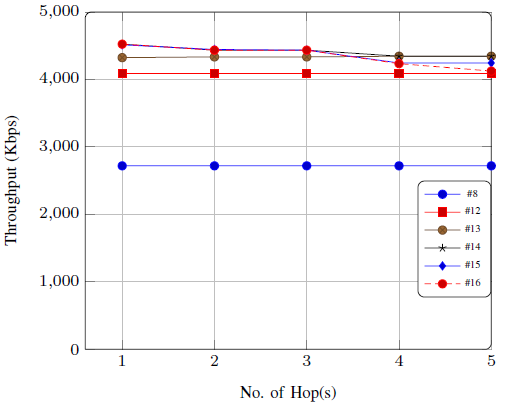 | Figure 3. Throughput achieved by video conferencing traffic |
 | Figure 4. Throughput achieved by video streaming traffic |
4.4. Delay Characteristics
- Maximum tolerable delay of VoIP, video conferencing, and video streaming traffic is about 150 ms. As seen in Figure 5, delay with 40 and 45 number of VoIP connections are much higher than 150 ms. The delay limit for VoIP traffic is reached when the number of connections is 38 and number of hop is up to 3. The maximum tolerable delay limit can not be supported beyond 3 hops. Similarly, from Figure 6 and 7, it can be observed that delay of Video conferencing and video streaming traffic at more than 13 connections are higher than the delay limit. The maximum tolerable delay is reached with 13 numbers of connections and hop distance of less than 3.
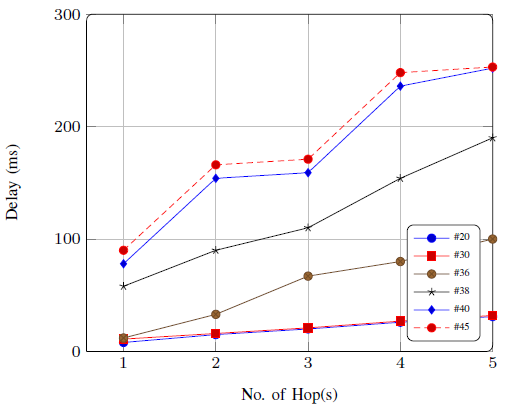 | Figure 5. Delay performance of VoIP traffic |
 | Figure 6. Delay performance of video conferencing traffic |
 | Figure 7. Delay performance of video streaming traffic |
4.5. Packet Loss Characteristics
- The tolerable packet loss for real-time traffic is less than 1%. The packet loss as seen in Figure 8, up to 36 number of VoIP connections can be easily supported. The maximum number of tolerable video conferencing and video streaming connections is 13 in both the cases which are shown in Figure 9 and 10.
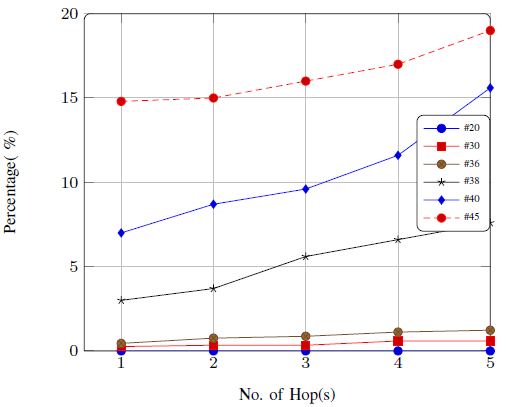 | Figure 8. Packet loss characteristics of VoIP traffic |
 | Figure 9. Packet loss characteristics of video conferencing traffic |
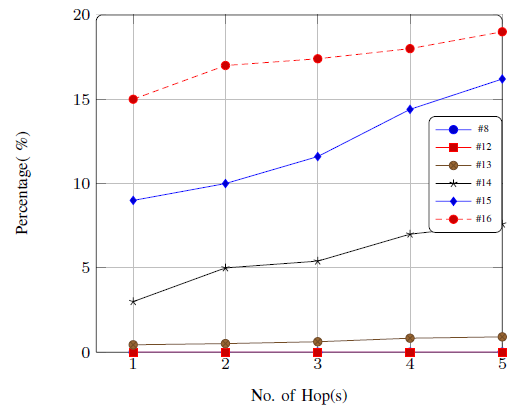 | Figure 10. Packet loss characteristics of video streaming traffic |
4.6. Jitter Characteristics
- The tolerable jitter value for real time audio and video are 100 and 150 ms respectively. With jitter constraint, 39 numbers of VoIP (Figure 11), or, 14 numbers of video conferencing or streaming connections (Figure 12 and 13) can easily be supported over WiLD networks.From the above results, it can be concluded that the maximum achievable throughput for VoIP traffic (2.4 Mbps) supports a maximum of 38 numbers of connections. However, as the hop distance between the nodes increases, this number slowly decreases. Similarly, about 13 number of video conferencing or video streaming connections can be supported in up to 5-hops distance. Delay performance of VoIP and video conferencing or video streaming is satisfactory for about 38 and 13 connections respectively but up to 3 hops distance only.
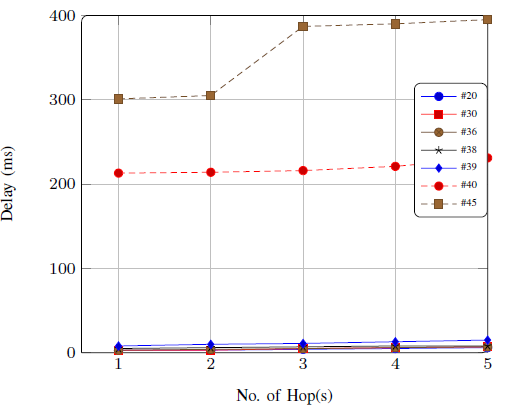 | Figure 11. Jitter characteristics of VoIP traffic |
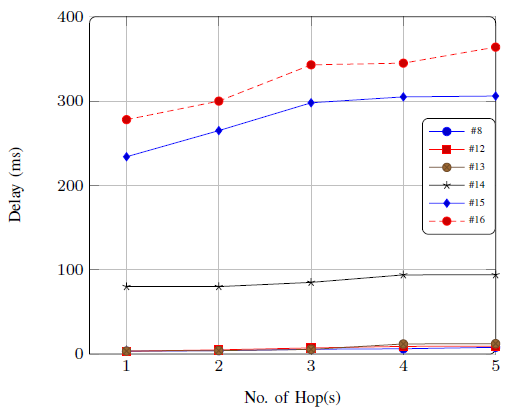 | Figure 12. Jitter characteristics of video conferencing traffic |
 | Figure 13. Jitter characteristics of video streaming traffic |
5. Some Research Challenges in Supporting E-Learning over WiLD Networks
- It is observed that a limited number of connections can be supported in WiLD network at a time. To support more number of connections, network capacity is required to be enhanced. In view of this a few important research issues is presented in this Section.
5.1. MAC Layer Challenges
- The existing CSMA/CA MAC protocol does not perform well in WiLD environment. The expected performance parameters of such networks in supporting e-learning cannot be delivered by the existing MAC protocols unless tuned or redesigned properly.When adjacent WiFi links operate on the same channel or in overlapping channels, interference among them is bound to happen. This is because of the fact that most directional antennas have sufficiently large side lobes with a gain of 4 to 8 dBi in addition to the main lobe. Therefore, the strength of transmitted signals from a high power radio on a node overwhelms any packet reception on other local radios [40]. A performance enhancement in such gateway-based multi-hop networks is a challenging task.
5.2. Quality of Service (QoS) Challenges
- QoS is all about giving higher priority to some traffic over others [41]. The network architecture must provide some sort of QoS guarantees for the envisaged real-time applications. The QoS parameters also vary from application to application.In tree-like networks, the traffic generated from the leaf nodes travel hop-by-hop towards the root in a many-to-one traffic pattern. Aggregation of traffic in the intermediate parent node and forwarding them to the root node creates some choke points. This traffic congestion in the nodes nearer to the root node is known as the funnelling effect. The funnelling effect of traffic leads to increased transit traffic intensity and delay as events move closer towards the root node. This may result in significant packet collision, congestion, and loss leading to failure in providing QoS for real-time application. To enhance performance inside the funnelling area, a scheduling scheme among the root node and children nodes is necessary to ensure end-to-end QoS. Hence, to meet the requirements of e-learning applications in WiLD networks, there must be a proper MAC and scheduling mechanism which will provide priorities to QoS-bound traffic over normal traffic.
5.3. Routing Challenges
- The existing routing protocols such as AODV, DSR, DSDV, etc., are not suitable for WiLD networks as these protocols work only in a single radio environment. Further, if a link gets congested due to local interference or traffic load, existing protocols do not provide any alternative way to resolve the problem locally and in real-time [42]. The WiLD network is configured in a tree topology with a root node which is the gateway to the Internet that takes the required centralized decisions. Taking the architectural advantage, most of the WiLD networks use the static routing protocol. However, such assumptions comprise reliability in the sense that the whole network topology is dependent on the single gateway (i.e., the central/root node). Failure of a link leads to the starvation of all the successor nodes from that predecessor node. In such case, a network consisting of multiple gateways where the nodes are connected by multiple links forming a mesh network could be a solution to the problem. Using a static routing protocol in multiple gateway networks, it will not be able to choose the alternative nearest gateway to forward the packet outside. Further, in static routing, the failure of a link will lead to starvation until a new gateway is chosen again. Therefore, the routing protocol in a multi-gateway rural network should provide support for continuing the ongoing communications by choosing another alternative gateway in real time.
6. Conclusions
- In this paper, the requirements of different e-learning applications have been studied. The feasibilities of supporting e-learning applications over the WiFi-based long distance network are analysed. The experimental results suggest that more effort is required to put in to run e-learning based application over WiLD networks smoothly. Some research challenges in making it a reality have also been put forward.
 Abstract
Abstract Reference
Reference Full-Text PDF
Full-Text PDF Full-text HTML
Full-text HTML


